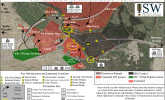 |
 |
Ramadi Control Map, Dec. 9, 2015
Dec 22, 2015 - Patrick Martin
The Iraqi Security Forces (ISF) achieved major gains in Ramadi and recaptured key terrain in the city’s environs on December 8. The ISF spearheaded by the Counter-Terrorism Service (CTS) launched an operation on December 4 to recapture Ta’mim, an area composed of Ramadi’s southwestern neighborhoods which ISIS captured on June 27, 2014. As of December 8, the ISF claimed to have seized all of the neighborhoods in Ta’mim as well as several bridges leading into central Ramadi. Iraqi Army (IA) formations from the 8th and 16th Divisions have entered Ta’mim to secure it and the bridges alongside local tribal fighters, while the ISF have sent at least one Federal Police Emergency Battalion composed of former local police from Habaniya base, east of Ramadi, to Ta’mim to hold the area. If the ISF is able to fully clear and hold Ta’mim, it will have multiple access points into central Ramadi from the southwest. ISW is changing the status of Ta’mim and several of its bridges to “Contested with ISF / Tribal Fighters presence.” ISW is also upgrading the status of the Anbar University compound, where the CTS is headquartered near Ramadi, to “ISF control.”
The ISF also made symbolic gains on December 8 when an Anbar Operations Command (AOC) operation led by the 10th IA Division successfully cleared the AOC headquarters compound northwest of central Ramadi. The compound was captured by ISIS in May 2015 and overlooks the Warrar Dam, an important water infrastructure facility that controls water levels for the Euphrates River that doubles as a bridge into central Ramadi’s Warrar neighborhood. ISW is upgrading the status of the AOC HQ compound to “ISF control.” The ISF are still engaged in clearing operations in the northern neighborhoods of Albu Faraj, Albu Thiab, and Albu Aitha according to the AOC commander. These areas remain exposed to counterattacks by ISIS.
The recapture of the Ta’mim area and the AOC HQ put the ISF in a position to begin preparations to recapture central Ramadi. The success of the Ramadi operation, which is led by the ISF and supported by the U.S-led Coalition, is critical for the Iraqi government and the ISF to exercise independence from Iranian influence. However, continued ISF success may lead to greater interference from Iranian proxy militias, some of which maintain a presence around the Habaniya base east of Ramadi but do not participate in Ramadi operations.Nujaba Movement, an Iranian proxy militia, claimed to have killed ISIS members during Ramadi operations, but there has been no indication of Nujaba Movement units are positioned near the front lines in Ramadi. Proxy militias will likely release similar disinformation in the future to discredit the ISF. PM Abadi is facing immense pressure from Iranian proxies to reject foreign support, particularly from the Coalition, in the wake of a unilateral deployment of Turkish troops to the outskirts of Mosul on December 4. Defense Secretary Ashton Carter’s December 9 proposal to deploy attack helicopters and “accompanying advisers” to assist the IA in recapturing Ramadi could offset this pressure by showing strong support for the ISF. U.S. support will also expedite the swift recapture of the city, underscoring the importance and effectiveness of the U.S. in the anti-ISIS fight.
